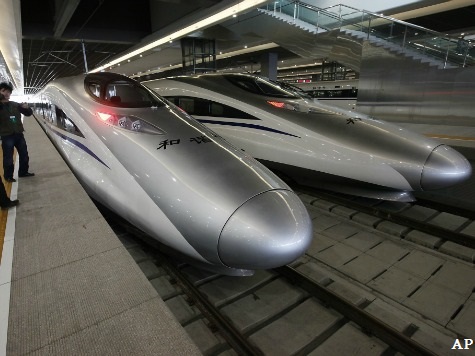Hailing it as a breakthrough for commuters and an important economic development tool, the mayors of Dallas, Fort Worth and Houston last week announced their support for a privately funded high-speed train between the state’s largest metropolitan regions, according to local reports. Skeptics say the train is likely to be little more than a fast-track for taxpayer dollars into a wasteful spending engine.
Two years ago, the Texas Central Railway announced plans to construct a rail line taking passengers between Houston and Dallas at speeds of 200 mph, making the trip in just 90 minutes. State and federal agencies are both expected to soon begin environmental impact studies, the first step in securing regulatory permission to begin work.
According to media reports, the Texas Central Railway will be built without any public subsidies. The Texas Tribune has reported that the firm is being financed in part by Central Japan Railway. That company was formed in 1987 out of the government-owned Japanese National Railways.
Chuck DeVore, vice president for policy at the Texas Public Policy Foundation is skeptical that the project will be a truly private enterprise or live up to the company’s self-generated hype. That skepticism is rooted in his experience as an assemblyman in California, where that state’s public-private high-speed rail line is costing twice what was forecasted and tickets are highly subsidized.
“You can drive from Dallas to Houston in 3-1/2 hours, 239 miles. Or fly and take an hour. The problem with flying or taking a train is that you need to make transportation arrangements at the other end, either taxi or rental car,” said DeVore in an interview with Breitbart Texas. “The train has an additional challenge in typically not reaching it full speed over the entire route. For instance, Conroe and Corsicana may want to get in on the stops, and each stop reduces the average travel speed, making the train less competitive with a flight.”
Indeed, Texas Central Railway president Robert Eckels–former Harris County judge–recently told the Houston Business Journal that the company already plans to make a stop just outside of Houston in The Woodlands.
DeVore said that political interests, more than economic ones, have been the driving force in adding delay-causing stops in Texas.
It is estimated 50,000 people make the weekly trek between Houston and Dallas more than once a week, according to the Dallas Morning News. DeVore says that half of those people would have to take the train–every week–in order to just pay the interest on a loan to construct such a rail line.
Whether Texans in the 21st Century will flock to a 19th Century mode of transportation remains a question. DeVore does not believe they will.
“Around the world, high-speed rail cost more than flying and takes longer, with the exception being cities that are close together and require connections,” he said.
According to a 2013 report from the Reason Foundation, “the cheapest European rail line costs more than $50,000 per seat to operate annually.” DeVore notes that the lowest European high speed rail operating costs are $0.013 per seat mile, the highest is $0.338. In comparison, DeVore calculates the proposed Texas line would see costs run between “from $2.93 to $76.12” excluding maintenance costs.
All that, according to DeVore, makes it unlikely the line would be able to operate without taxpayer subsidies.
Terri Hall of the anti-toll Texans United for Reform and Freedom says this is another version of the failed Trans Texas Corridor pushed by Gov. Rick Perry early in his tenure. The TTC was derided for its heavy use of eminent domain and reliance on public-private partnerships. The Texas Legislature eventually scrapped the TTC.
“They always like to tout how a private company is building it and no taxpayer money is involved, but that’s simply not the case,” she said. “All (passenger) rail is heavily government subsidized.”
Hall said she expects the project to at least benefit from the use of eminent domain. She said advocates want “to exploit the government’s power of eminent domain to steal Texans land and pay them dirt for it.”
In the early 1990s a private high-speed rail connecting Dallas, Houston and San Antonio was proposed but failed to attract investors.
Follow Michael Quinn Sullivan on Twitter @MQSullivan

COMMENTS
Please let us know if you're having issues with commenting.